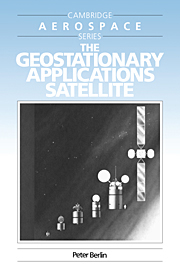Book contents
- Frontmatter
- Contents
- Dedication
- Preface
- List of Acronyms
- 1 Launch vehicles
- 2 The transfer orbit
- 3 The geostationary orbit
- 4 The satellite environment
- 5 Structures
- 6 Mechanisms
- 7 Thermal control
- 8 Power supply and conditioning
- 9 Propulsion and orbit control
- 10 Attitude stabilization, measurement and control
- 11 Telemetry, tracking and command (TT&C)
- 12 Communications payload
- 13 Meteorological payload
- 14 Product assurance
- 15 Spacecraft development and testing
- Index
13 - Meteorological payload
Published online by Cambridge University Press: 02 February 2010
- Frontmatter
- Contents
- Dedication
- Preface
- List of Acronyms
- 1 Launch vehicles
- 2 The transfer orbit
- 3 The geostationary orbit
- 4 The satellite environment
- 5 Structures
- 6 Mechanisms
- 7 Thermal control
- 8 Power supply and conditioning
- 9 Propulsion and orbit control
- 10 Attitude stabilization, measurement and control
- 11 Telemetry, tracking and command (TT&C)
- 12 Communications payload
- 13 Meteorological payload
- 14 Product assurance
- 15 Spacecraft development and testing
- Index
Summary
Introduction
Atmospheric pressure, temperature, humidity, wind speed, and sea surface temperature are fundamental parameters for determining the weather. If it were possible to measure these five parameters simultaneously across the globe at regular time, distance and height intervals, the problems of medium- and long-range weather forecasting would be greatly reduced.
Before the advent of satellites, global weather measurements on such a scale would have been totally impracticable. Systematic meteorological observations used to be extremely sparse. Although most industrialized countries maintained a network of ground-level observation stations, vertical sounding was limited to launching occasional balloons from land and sea, and receiving sporadic reports from commercial aircraft. These horizontal and vertical measurements covered only a small portion of the earth, forcing meteorologists to bridge the gap with educated guesses.
In the late 1940s, sounding rockets equipped with cameras took pictures of the earth from altitudes of 100 km and more. These early photographs revealed a whole new family of physical relationships in the atmosphere. In the years that followed the launch of Sputnik in 1957, much effort was devoted to developing television cameras and radiometers suitable for satellite meteorology. Throughout the 1960s, the United States and the Soviet Union deployed a host of increasingly powerful weather satellites which transmitted visible and infrared images to ground stations on the earth. The first steps towards making global weather observations had been taken.
Low-orbiting Satellites
The early meteorological satellites were launched into low earth orbit by necessity, since rockets in those days had limited lifting capacity.
- Type
- Chapter
- Information
- The Geostationary Applications Satellite , pp. 180 - 188Publisher: Cambridge University PressPrint publication year: 1988



